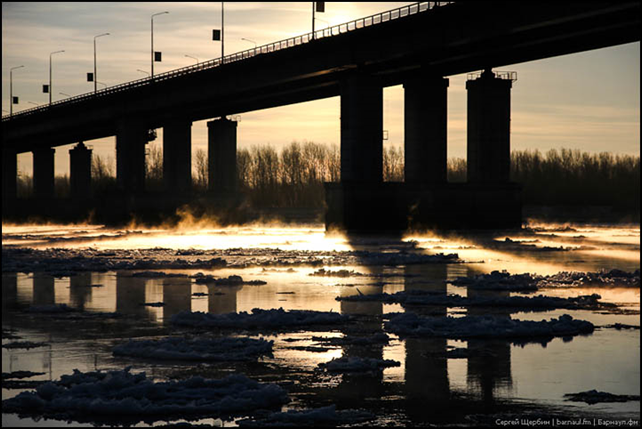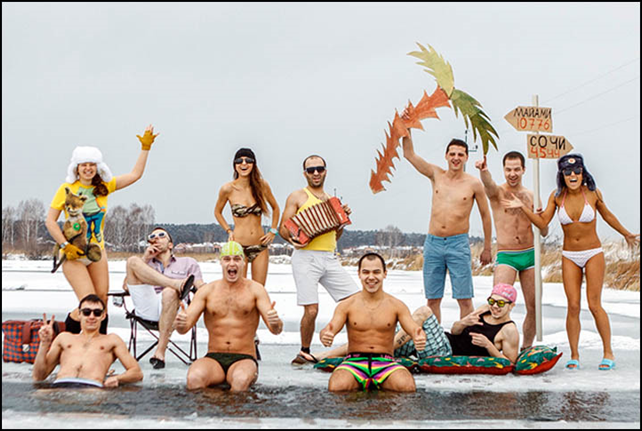Locals marvel and worry at the ‘snow shortage’ in Siberia – ‘I cannot believe my eyes. This doesn’t happen.’
By Anna Liesowska
17 December 2013 (Siberian Times) – We highlight December images taken in recent days in two Siberian cities Krasnoyarsk and Barnaul showing scenes that locals insist are unprecedented in living memory. The startling pictures from Krasnoyarsk show an almost total absence of snow yet as every school child around the world knows, snow is what Siberia is all about. No more, it seems. The images of the River Yenisei with ducks splashing in the water, and grass in the parks, could be from autumn rather than deep in the winter in a city where December temperatures have gone as low as minus 47C, and the daily mean in minus 13C at this time of year, with plenty of snow on the ground. As in many areas of Siberia this winter, the thermometer is reluctant to plummet to customary bone-chilling temperatures. Last night when we checked outside, it was a mere minus 3C. Day time temperatures lately have been warmer. As mother-of-two Anastasia said from Krasnoyarsk: ‘I’m reading a book to my children and I hear the tapping of the rain in my ear. Rain? Rain? Rain in the middle of December? In Siberia?’ Sergey Scherbin’s images and footage from the historic west Siberian city of Barnaul – gateway to the Altai Mountains – are every bit as stunning, but not just because of the haunting beauty of the river scenes. The iceflow on the mighty Ob resembles the spring snow melt. This December scene is out of sync with the natural cycle. By this time of year, many Siberians expect to be fishing through thick ice on their rivers, and driving their vehicles over these sturdy ‘winter roads’.
Not here. A similarly warm winter – and a lack of snow – has been reported from many places across Siberia and is a talking point especially among our senior citizens who can give some perspective to the debate. ‘I cannot believe my eyes,’ said one elderly local in Barnaul. ‘This doesn’t happen’. In Novosibirsk, we asked 83 year old Fyodor Olifirenko to compare this winter to others he has known. ‘I do not remember such a warm December,’ he said. ‘In 1963 there was some thaw on December 24-25, it was raining a bit. But by morning all was frozen and after that started strong frosts. But such weather – when it is constantly raining in the middle of December – I see this for the first time’. […] Academician Vladimir Kotlyakov, honorary president of the Russian Geographical Society, highlighted the rapid process of melting Arctic ice. He believes that it will bring ‘climate anomalies, non-uniform in space and time which will have mixed effects, including within the territory of Russia’. He forecast: ‘The entire modern way of life on Earth is that any global climate change may be adverse for people. The fact is that the entire current economic way established and rapidly developed only in a narrow interval of time – almost the last century. Because of this, it has adapted to the same climatic environment.’ [more]
No snow in Siberia? Locals marvel – and worry – at the ‘snow shortage’ 
By Richard Angwin
19 December 2013 (Al Jazeera) – Think of Siberia and images of a cold, bleak, icy, snow-swept landscape come to mind. The reality is that this remote northern region of Russia is experiencing unseasonably warm weather that is changing the very nature of the landscape. In some areas ice and snow are being replaced by heavy rain and green grass. Many lakes and rivers, which would normally be ice-bound at this time of year, are flowing freely. During December the region would normally expect to be in the grips of winter. Although it remains cold here with the threat of snow, conditions are nowhere near as extreme as would normally occur. In the northern city of Verkhoyansk average maximum temperatures are around minus 47C. Currently, they are some 14C warmer at minus 32C. The southern city of Irkutsk is experiencing temperatures of minus 6C, ten degrees above average and this pattern is being repeated across much of the region. What makes this change particularly interesting is that it seems to be part of a longer-term trend. The warmer weather has been in evidence for several months. Back in July, Norilsk, the most northerly city in the world, recorded temperatures above 28C for eight consecutive days. Maximum temperatures here usually reach no higher than 16C. Such temperature anomalies were widespread across Siberia during the month. Although temperatures have been increasing globally, since the mid-1970s temperatures here have risen by 0.34C per decade faster than the global average of 0.17C. [more]

